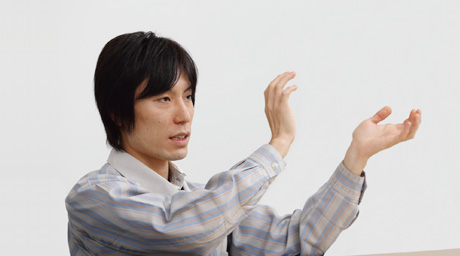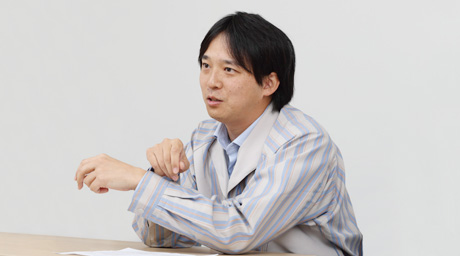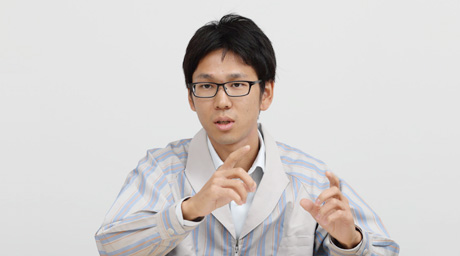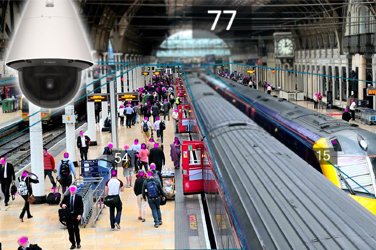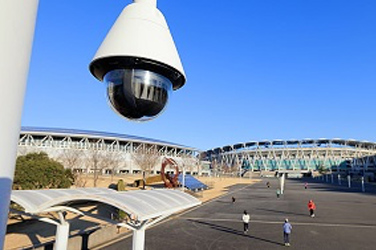Network camera The Story Behind the Development of the VB-R11VE
The VB-R11VE is Canon’s first 360-degree rotating network camera for all-weather outdoor use. In this roundtable discussion, four engineers who were involved in the camera’s development talk about their passion for this product, the advanced technology that went into its creation and what the future holds for network cameras.
POINT 1
The VB-R11VE is tough enough to withstand harsh environments.

The VB-R11VE is Canon’s first 360-degree rotating dome-type pan-tilt- zoom (PTZ) network camera for all-weather outdoor use. How was this camera made robust enough to withstand severe temperatures as low as minus 50 degrees Celsius and up to 55 degrees Celsius and protect against certain acts of vandalism?
Hiroyuki Horii
Area of technical expertise: Electrical design
During the planning of the VB-R11VE network camera, what kind of applications did you have in mind?
Hiroyuki Horii
The VB-R11VE was designed as a 360-degree fully rotating all-weather high-end model for use in wide-open outdoor areas like parking lots. Since it’s intended for outdoor use, it had to be able to withstand widely varying temperatures and needed a high-magnification zoom lens to capture images over long distances. As a Canon product, it’s a given that it had to deliver high image quality, but we also provided it with the industry highest level of low-light performance, enabling the capture of clear images even in dark settings. This was the concept we were aiming for with the VB-R11VE.
Daisuke Sasaki
Area of technical expertise: Mechanical design
The unique conical shape is striking.
Daisuke Sasaki
The reason why it’s cone-shaped is to allow rain and wind to easily flow around the camera. What’s more, we made the top of the cone rounded to ensure that the camera’s design blends in with its surroundings.
The camera’s operating temperature range of minus 50 degrees Celsius to 55 degrees Celsius is extremely wide. Was it difficult designing it to withstand such a wide variance in temperature?
Sasaki
Because I hadn’t ever worked on a product that had to accommodate such a wide operating temperature range, it was a continuous process of trial and error.
First of all, to handle changes in temperature, the inside of the white sunshade has a dual-layer construction made of diecast aluminum and molded plastic. When the temperature is high, air flows between the diecast aluminum and the plastic to dispel heat through the vents in the sunshade. When it’s cold, a heater warms up the inside of the plastic section, which has a thermally insulated structure.
Does the lens ever fog up due to condensation?
Sasaki
Like ski goggles, this product always circulates the air inside of it, feeding air into the dome to prevent condensation. We tested for various conditions through trial and error to determine how much warm air should be generated by the heater, and how the air should flow through the space between the dome and the black inner cover. It was quite a challenge to prevent the entire dome from fogging up.
The camera also offers shock resistance, right?
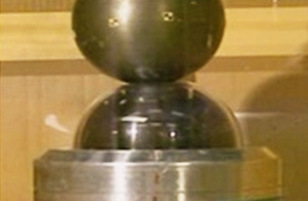 The IK10 rating denotes resistance to the impact of a five kg weight dropped from a height of 40 cm.
The IK10 rating denotes resistance to the impact of a five kg weight dropped from a height of 40 cm.
Sasaki
The VB-R11VE achieves IK10 classification*, a level of external shock protection capable of enduring the impact of a five kg object dropped from a distance of 40 cm.
In the IK10 impact resistance test, a five kg iron ball is dropped onto various parts of the product, including the dome, to verify that it can withstand the impact of such a drop. While most conventional surveillance cameras have domes that are thick enough to withstand such an impact, the thickness of the VB-R11VE’s dome was intentionally made thinner for improved image quality. The dome is made of polycarbonate, which provides greater flexibility, but this alone would not be sufficient to protect the camera inside from an impact. That’s why we added the black inner cover inside the dome, which serves to absorb impacts.
Actually, during development, a system integrator in charge of sales in the U.S. suggested that making the camera vandal-resistant would be an indispensable selling point for the U.S. market, where vandalism can be a problem. Once we better understood the global market, which called for products capable of withstanding such harsh conditions, we made significant changes to our initial design.
- * IK codes, defined in the European Standard EN 50102, specify the degrees of protection provided by enclosures for electrical equipment against external mechanical impacts.
POINT 2
Precision-control technology ensures accurate tracking and stopping.

Capable of rotating 450 degrees per second, the VB-R11VE combines high-speed performance with high-precision image-capture features, including 30x optical zoom. The VB-R11VE represents the fruition of Canon’s expertise in optical sensors and precision motor-control technology.
Shunsuke Chino
Area of technical expertise: Firmware development
How did you enable the camera to rotate a full 360 degrees?
Shunsuke Chino
If it was less than 360 degrees, then the image-capture components, like the lens and the CMOS, could be connected to the other parts by cable, but since it rotates 360 degrees, a cable would twist.
That’s why we decided to use a slip ring mechanism. It employs a structure with a fixed brush that makes contact with a rotating slip ring.
When the image-capture unit rotates, friction is generated between the slip ring and the brush, so we carried out repeated tests to ensure durability. For example, we’ve verified that the camera is more than capable of operating trouble-free even if the image-capture unit rotates more than twice its target durability rotation frequency.
The lens doesn’t just have to rotate, it also has to stop quickly and accurately at the targeted location, right?
Chino
When panning (lateral motion of the camera), it rotates 450 degrees per second. By increasing or decreasing the rotation speed with rapid acceleration or deceleration, we were able to reduce the time required to reach the target location. Furthermore, in order to stop the lens precisely at the intended location, we used a Canon SR encoder, which is a kind of sensor that detects positions by reading an indexed pattern with high accuracy. By using the SR encoder, we were able to realize exceptionally high-precision camera positioning.
The zoom magnification is as also quite high at 30x.
Chino
Equipped with a 30x optical zoom lens, the camera enables the clear identification of a person’s face at a distance of 60 meters.
In working to combine a wide 58.4-degree viewing angle at the wide-angle end with the 30x optical zoom, we had a hard time with the camera control. If the positioning of the focus lens*1 and zoom lens*2 aren’t controlled precisely, the image won’t be in focus when zooming in or zooming out. The position at which the focus lens realizes proper focus varies slightly not only during the acceleration and deceleration of the motor when zooming, but is also affected by the position of the lens relative to the outer dome. Through repeated simulations and verifications using the actual product with the lens designers and mechanical designers, we were able to create a dome-type network camera with zoom capabilities that combine both high magnification and high performance.
Because of the high magnification factor and the fast panning speed, when just zooming or panning, on-screen images will appear jumpy to users. To solve this problem, we modified the acceleration and deceleration of the pan/tilt drive motor to realize both high speed and high precision so that it will appear to users that the camera is moving smoothly.
We took into consideration all factors, including the angle of the dome, the orientation of the lens, and acceleration and deceleration, to ensure the smooth operation of the 30x zoom and panning functions.
- *1 The lens used to bring the image into focus
- *2 The lens used to change the angle of view
You also put a lot of effort into the camera’s low-light performance, to enable video capture even in dark environments, right?
Chino
Yes, enabling image-capture in dark environments, the camera can even generate color images with as little as 0.03 lux of illumination. This exceptional low-light performance was made possible through the combination of the camera’s lens, CMOS sensor and image-processing capabilities.
First, for the lens, we used a very fast one with an f-number* of f/1.4. To achieve a small f-number, the lens must be able to allow a large amount of light to enter the camera, which results in an increased lens diameter. As the lens diameter increases, aberrations become more pronounced, resulting in a decline in image resolution. The VB-R11VE makes use of high-precision aspherical lens elements and high-refractive-index glass, thus making possible the combination of a large lens diameter with compact dimensions and high performance.
As for the CMOS sensor, we selected the most suitable type of sensor after considering noise characteristics. Furthermore, taking advantage of technologies we’ve cultivated to date, we applied corrective processing in response to the noise characteristics to maximize the sensor’s performance.
And finally, with regard to image processing, the VB-R11VE takes advantage of Canon technologies that we’ve cultivated through the development of digital cameras and video camcorders. On top of that, adjustments were made for sharpness, contrast and noise balance, making it ideal for use as a surveillance camera. We also added such new technologies as Haze Compensation.
- * A reciprocal number used as a lens brightness index that is determined by dividing the lens diameter by the focal length. The lens allows more light to enter the camera as the f-number decreases, which makes it more suitable for capturing images in dark environments.
POINT 3
A network camera with intelligent functions

The VB-R11VE is equipped with nine Intelligent Functions*, including Scream Detection and Auto-Tracking. The software, which includes video-content analysis capabilities, was realized through an enormous amount of trial and error by the developers.
- * VB-R11VE feature a range of Intelligent Functions: Moving Object Detection, Removed Object Detection, Abandoned Object Detection, Camera Tampering Detection, Passing Detection, Auto-Tracking and Intruder Detection, Volume Detection and Scream Detection.
The VB-R11VE features such Intelligent Functions as Scream Detection and Auto-Tracking. What kind of challenges did you face in developing these capabilities?
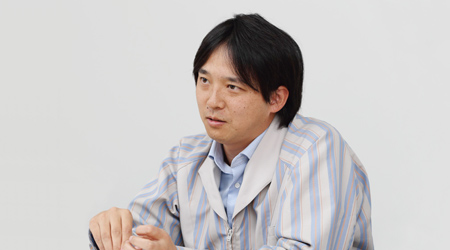
Chino
Since this was the first time we incorporated Scream Detection, we began by collecting data internally and externally from both males and females based on a variety of situations. Although we made use of a voice-research data library, in order to gain a full understanding of some aspects, we had to carry out our own field studies. We asked some people in the company to scream for us and analyzed the data we collected. We also gathered data from noisy train stations and similar locations to ensure that the system could detect screams amid ambient noise.
The challenges we encountered with the Auto-Tracking feature had to do with the zoom function. Too many fine movements by the camera can make the person viewing the on-screen images feel dizzy. We carried out repeated testing to determine the proper balance between the degree to which the camera should zoom and pan based on the movement of the object being tracked.
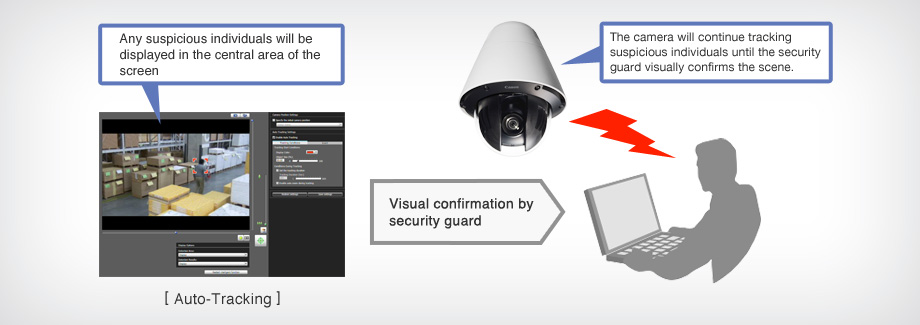 Intelligent Function: Auto-Tracking
Intelligent Function: Auto-Tracking
Takumi Kimura
Area of technical expertise: Software development
Ease of operation is also important for network cameras, and not just in terms of the hardware, but also for such aspects as monitoring and recording applications.
Kimura
To enable users to take advantage of the features of the 360-degree fully rotating VB-R11VE, we needed an easy-to-use user interface that let them quickly move the camera to view any location they want to see. That’s why we added Drag to Move and Area Zoom functions to the camera’s viewer application.
Drag to Move is a function that lets users move the camera in the direction of their choice by selecting and dragging an on-screen arrow in the desired direction. The speed of the camera’s movement changes depending on how far the user drags the arrow. To develop this function, we shot footage of people walking and of cars, and made repeated adjustments to the balance to ensure that users can easily track on-screen targets.
Area Zoom makes possible an enlarged view of any designated area of the on-screen image. Users simply specify the area of the image they would like to enlarge by clicking and dragging on the screen, and the camera automatically zooms and pans accordingly. The user doesn’t need to think about such things as the orientation of the camera or how much it needs to move to see the intended area, as the function does all the work by zooming into the target area instinctively and instantaneously. We also included a zoom-out function that is activated by dragging the cursor from the bottom right-hand corner of the screen to the upper left-hand corner. This lets users check the surrounding area immediately after zooming into a desired area.

POINT 4
Expanding the potential of network cameras through integration with the Internet of Things

The Internet of Things (IoT), currently a trending topic, refers to the network of connected devices that are capable of autonomously intercommunicating. Network cameras represent one component of the IoT, and can contribute to creating solutions that can enrich society.
In what fields do you think we will see applications for network cameras in the future?
Kimura
First of all, we are seeing rapidly increasing demand for surveillance, the primary application for network cameras. Lately, we’ve been seeing more and more criminal cases solved using recorded images of perpetrators identified from surveillance cameras. With major sporting events on the horizon, I believe network cameras will enable further progress to be made in the security field, such as supporting counterterrorism measures and preventing food tampering. Additionally, in terms of marketing applications, we’ve developed functions capable of counting numbers of people, determining the flows of people, and estimating queue wait times. In the future, these functions will be closely linked with big data analysis.

Horii
And I believe we’re going to see more intelligent functions on the camera side in the future. They’ll be able to detect the movement of people and objects as well as determine numbers of people, and transmit this data along with the image data to servers. Of course image analysis is possible on the server side, but as the number of cameras increases, the burden on the servers will become enormous.
Could you share with our readers your thoughts on the future potential of network cameras and any other interesting features you can think of?
Horii
Previously, we made network cameras, but now our aim is to create various solutions that make use of the video from these cameras.

Kimura
Through the combination of image analysis and networking, we believe that, depending on the idea, most anything is possible. Integrating various sensors, in addition to cameras, could enable a wide variety of applications in fields like marketing and health care.
I’m guessing that it’s important to determine what kinds of solutions can be created, not just from camera technologies, but from a combination of technologies.

Chino
The Internet of Things, made up of interconnected devices, has been attracting a lot of attention. Network cameras, as well as other sensors, will become one component of the IoT. In addition to crime prevention and marketing applications, we will likely see the creation of even higher added value solutions in the future. The network camera market is still developing, and I think that we can contribute to the creation of this industry along the way.
Even within the electronics industry, network cameras are recognized as a field undergoing rapid growth. Until now, network cameras have mainly been used as surveillance cameras to prevent crime and accidents, but in the future, in addition to this demand, we expect to see them increasingly used in areas such as marketing, health care and agriculture.
In the field of marketing, for example, analyzing big data regarding what kinds of customer pick up which products could lead to more effective sales methods and the development of highly appealing products.
If we’re able to handle real-world situations as digital data, we could create any number of new services that we can’t even imagine today. It’s not just a pipe dream to envision network cameras playing an important role as the “eyes” of drones and robots.
The VB-R11VE, which can be used even in harsh outdoor environments, will enable us to realize the potential of a new world made possible through network integration.
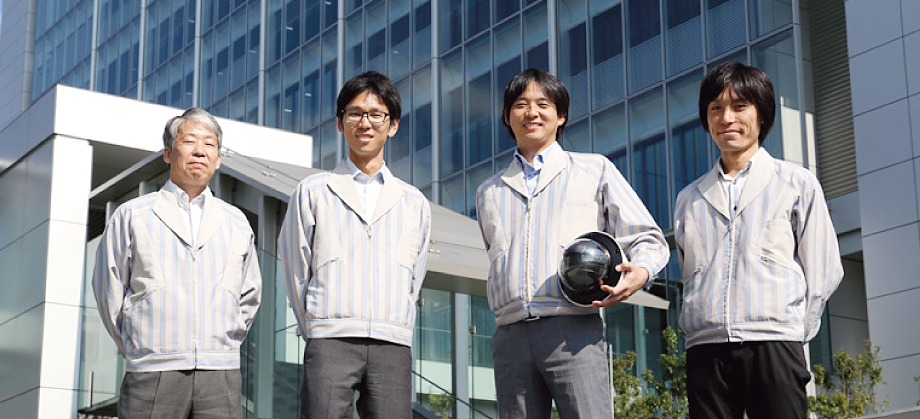
Interview & Composition
Tatsuya Yamaji
Born in 1970. After working as a magazine editor, he became a freelance writer/editor and has been active as a researcher, interviewer and writer in the fields of IT, science and the environment.
Publications include The Day Apple and Google Become Gods (co-author), New Guide to Superconductivity, 72 Hours of Google (co-author), Affirmation (co-author), and others.
Developers interviewed

Hiroyuki Horii
- Area of technical expertise:
- Electrical design

Shunsuke Chino
- Area of technical expertise:
- Firmware development
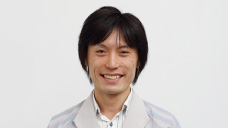
Daisuke Sasaki
- Area of technical expertise:
- Mechanical design

Takumi Kimura
- Area of technical expertise:
- Software development












